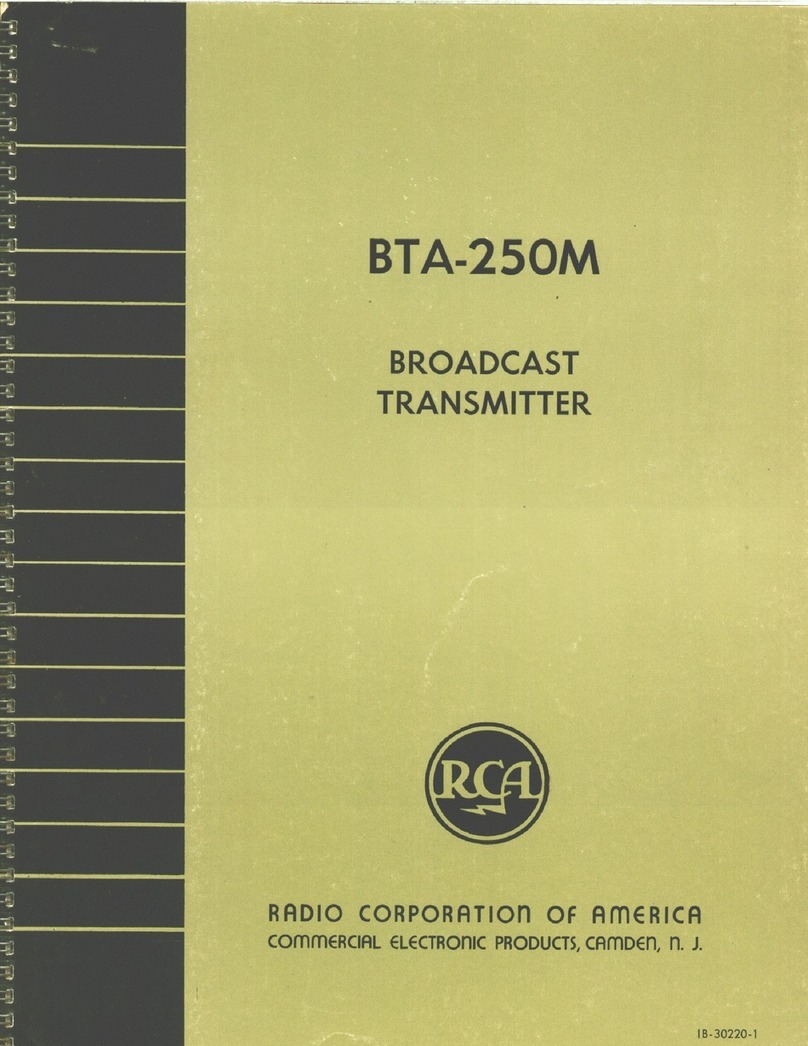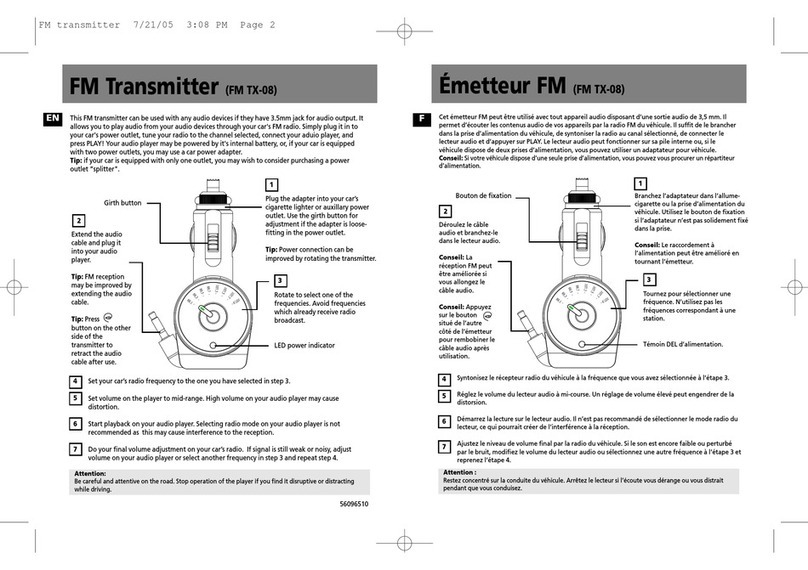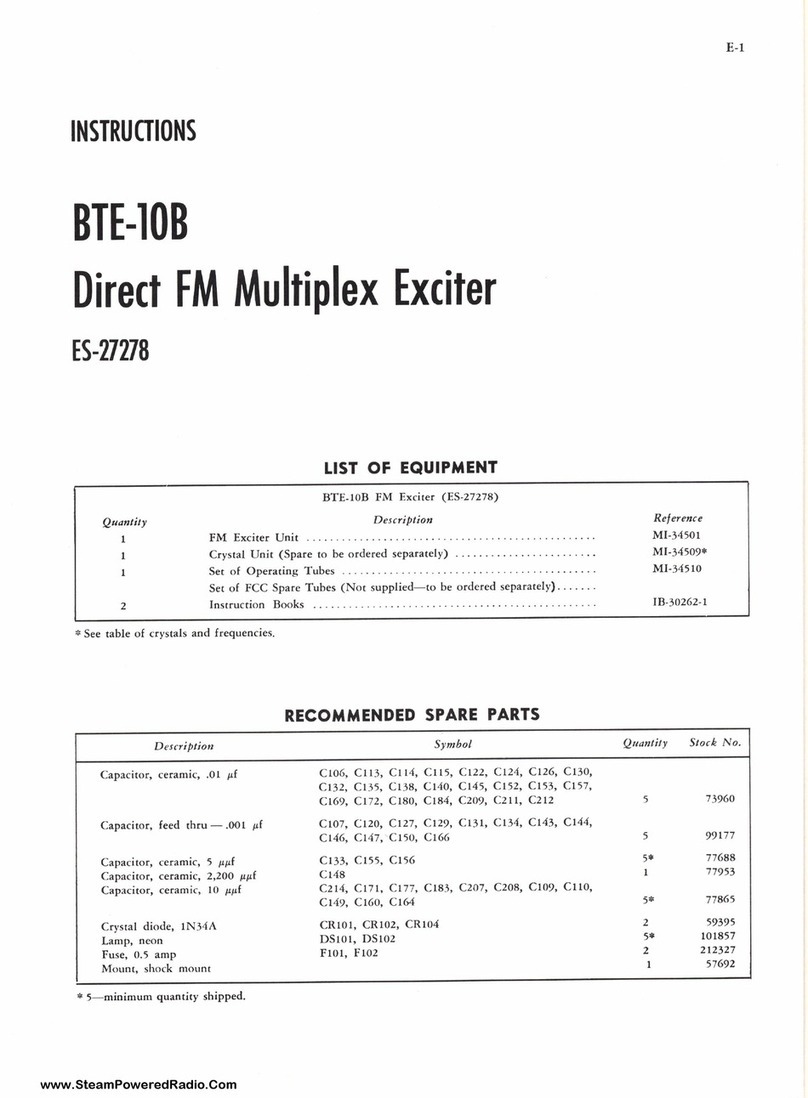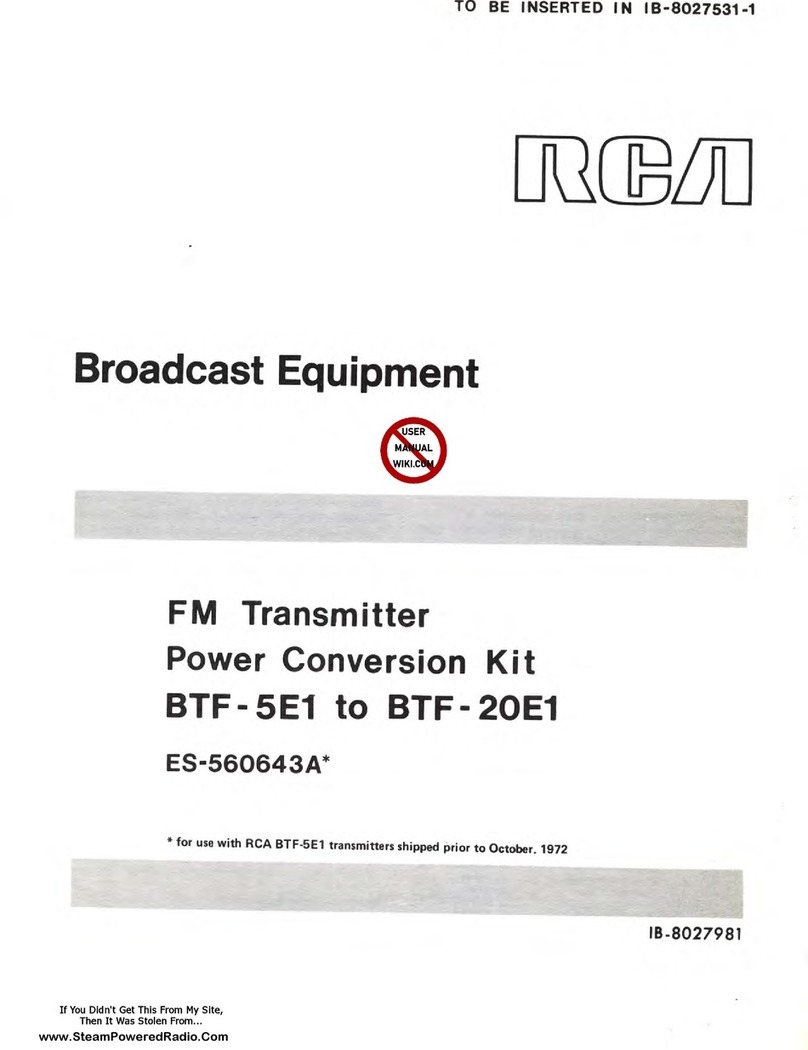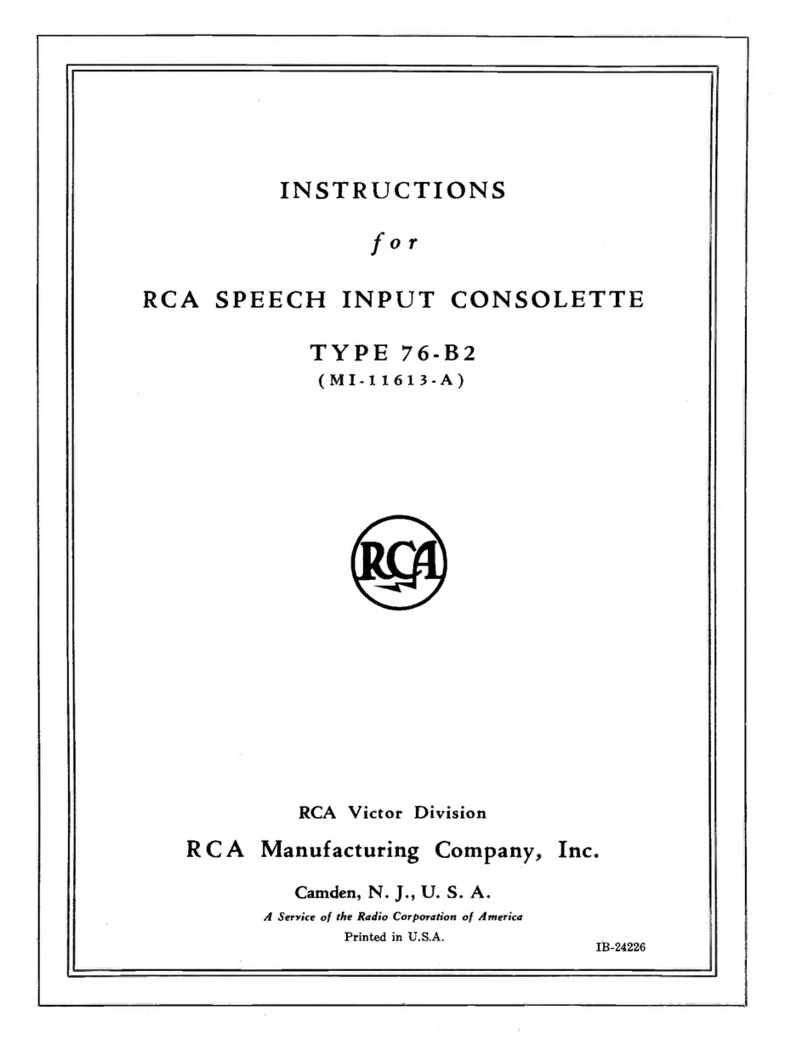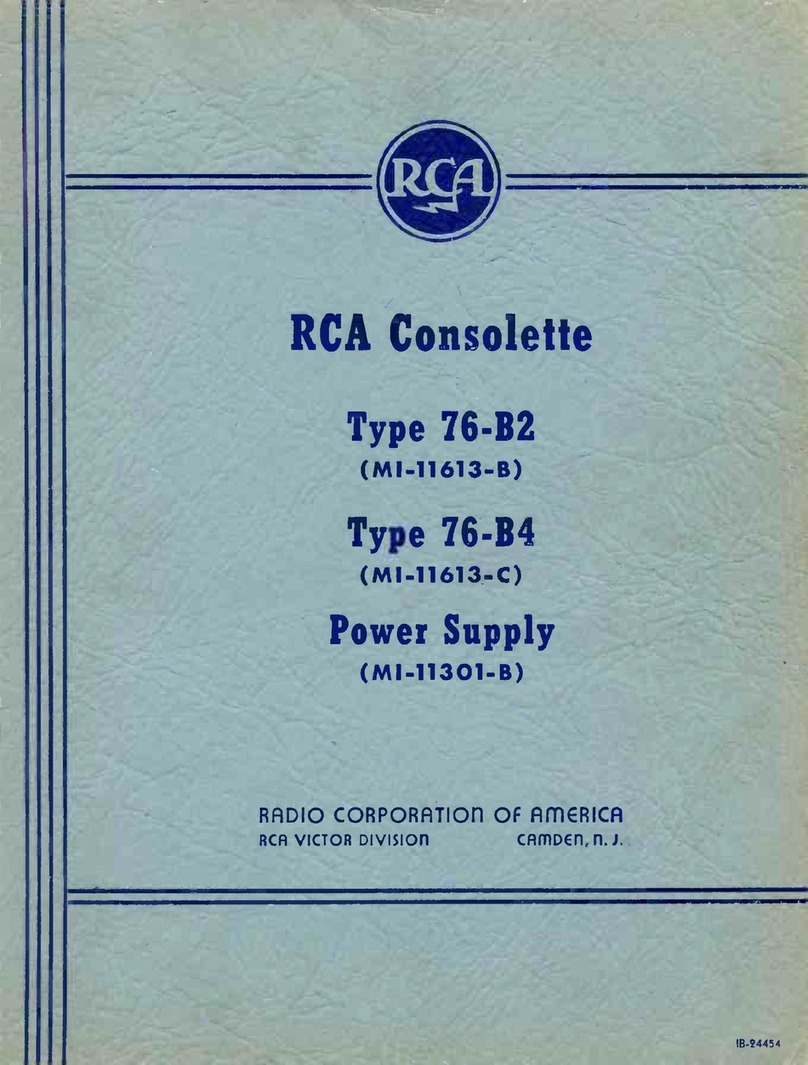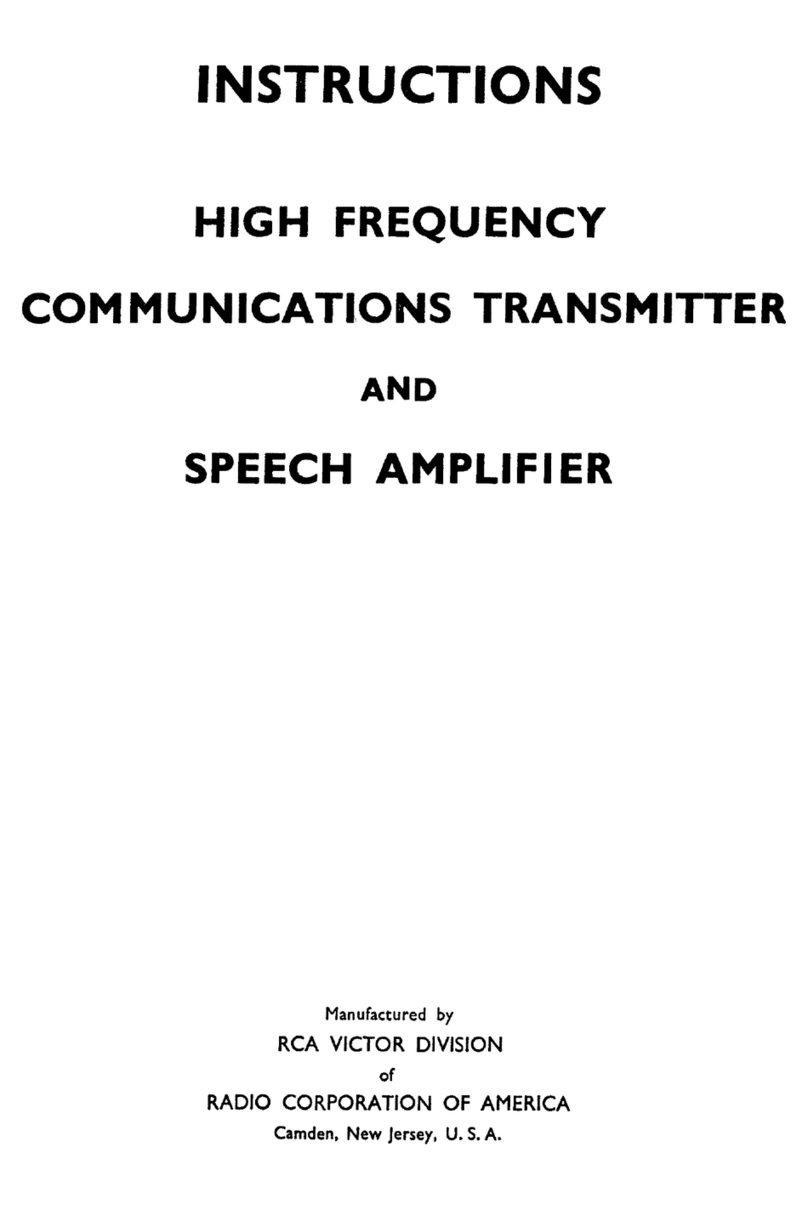
www.SteamPoweredRadio.Com
BTE-
11
5
FM
EXCITER
SYSTEM
OPTIONS
The
BTE-
11
5
FM
Exciter
System
is
available
in
several
forms
as follows:
1.
Mono
(A)
(B)
(C)
(0)
System,
ES-560982,
includes
1 Exciter, less audio
LPF,
5
MHz
crysta
l
and
oven
(Specify
1 5
MHz
reference
crystal
and
oven
(Instal
l
ed
in Exciter)
l Plu
g-in
15
kHz
audio L
PF
for
BTE-115
1
Con
n
ector,
Audio
lnout
frequency)
2.
Mono
and
l .
SCA
Sys
tern,
ES-560983,
includes
(A)
l Exciter,
less
audio
LPF,
5
MHz
crystal
and
oven
(Specify frequency)
(B)
1 5
MHz
reference
crystal
and
oven
(Installed
in Exciter)
MI-56
1
060
Ml-561066
MI
-
56
1
063
Ml-561067-1
MI-561060
MI-561066
V
(C)
l
BTX-
1
01
SCA
generator
less
audio
LPF
(Specify freq.
41
or
67
(D)
l Plug-in 15
kHz
audio
LPF
for
BTE-
11
5
kHz.
std
.)
lo'
1-561062
(E) 1 Plug-in 5
kHz
audio
LPF
for
SCA
unit
(F) l Interconnecting cable
3.
Mono
and
2
SCA
System,
ES
-560984, includes
(A)
1 Exciter,
less
audio
LPF
, 5
MHz
crystal
and
oven
(Specify frequency)
(B)
1 5
MHz
reference
crystal
and
oven
(Installed
in Exciter)
(C)
2
BTX
-
101
SCA
generators,
less
audio
LPF
(D)
l Plug-in 15
kHz
audio
LPF
for
BTE-115
(E)
2 Plug-in 5
kHz
audio
LPF
for
SCA
units
(F) 1 Interconnecting cable for
BTE-115
Mono
and
2
SCA
systems
4.
Stereo
System
,
ES
-560985, includes
!
A)
l Exciter,
less
audio
LPF,
5
MHz
cr.ystal
and
oven
(Specify frequency)
B)
1 5
MHz
reference
crystal
and
oven
(Insta
lled in Exciter)
C)
l
BTS-101
Stereo generator
less
2 audio L
PFs
D)
1 Plug-in
15
kHz
audio
LPF
for
BTE
-1
15
(E)
l
Pair
of plug-in
15
kHz
audio L
PF
for
BTS-101
(F) l Interconnecting cable
for
BTE-1
15 Stereo system
5. Stereo
and
1
SCA
System,
ES-560986,
includes
(A)
Ex
citer,
less
audio
LPF,
5 M
Hz
crystal
and
oven
(Specify frequency)
(8) 1 5
MHz
reference
crystal
and
oven
(Installed
in
Exci
ter)
(C)
1
BTS
-
101
Stereo
gene
rator
less
2 audio
LP
Fs
(D)
1
BTX-101
SCA
generator
less
audio
LPF
(E)
1 Plug-in 15
kHz
a
ud
io
LPF
for
BTE-115
(F) 1
Pair
of
plu
g-in
15
kHz
audio
LPFs
for
BTS-101
(G)
l P
lu
g-in
5
kHz
audio
LPF
for
SCA
unit
(H)
1 Interconnecting cable
for
BTE-
11
5 Stereo
and
l
SCA
system
6. Stereo
and
2
SCA
System,
ES-560987,
includes
(A)
l Exciter,
less
audio
LPF,
5
MHz
crystal
and
oven
(Spec
if
y
(B)
l 5
MHz
reference
crystal
and
oven
(Installed
in Exciter)
(C)
1
BTS-
1
01
Stereo generator
less
2 audio L
PFs
(D)
2
BTX-101
SCA
generator less audio
LPF
(E)
1 Plug-in
15
kHz
audio
LPF
for
BTE-1
15
(F) 1
Pair
of plug-in
15
kHz
audio L
PFs
for
BTS-
101
(G)
2 Plug-in 5
kHz
audio
LPFs
for
SCA
units
(H)
1 Interconnecting
cable
for
BTE-115
and
2
SCA
sys
tems
frequency)
MI-561063
MI-561065
MI-561067-2*
Ml-561060
MJ-561066
MI-561062
MI-561063
Ml-561065
Ml-561067
-
3*
Ml-561060
MI
-
56
1
066
MJ-56106
1
Ml-561063
MI-561064
MI-56
1
06
7-4*
MI-561060
MI-56
1
066
MI-5610
61
MI-561062
MI-561063
Ml-561064
Ml-561065
Ml
-
561067-
6
M1
-56106
0
MI-561066
M
I-561061
MI-561062
MI-561063
MI-561064
MI-561065
Ml-561067-6
The
followi ng optional items
are
available
for
use with the
BTE-1
15
FM
Exciter System:
l . Spare 5
MHz
crystal and
oven
5
MHz
crystal
only
crystal
oven
on
ly
2.
Complet
e
set
of
connector pl
ugs
for
the
BTE-115
Exciter
3.
Compl
ete
set
of
connector plugs
for
the
BTX
-1
01
SCA
Generator
4. Complete
set
of
connectors pl
ugs
for the
BTS-101
St
ereo Generator
5.
Blank
aluminum
pa
nel,
1-3/4"
6.
Set
of
chassis s
li
des for
servicing
7.
Interface
a
nd
Radiate
Panel
8. Connector Kit for
Interface
Panel
9. Dri
llin
g
Temp
la
te
for mounting
exciter
system
*
tir
In
some
cases
an
MI-56
1067
Interco
nn
ect
Cab
le having a higher
dash
number
than
that
specified
may
be
supplied.
Required only
when
interface
pa
nel
MI
-
56107
1 and/or Interconnection
Cab
le
MI-561071
are
not used.
MI-561066
M
l-561066X
MI-561066A
MI
-561068**
Ml-551070**
MI
-561069**
MI
-
561072
Ml-561073
MI-561071
Ml-563485
3742738






